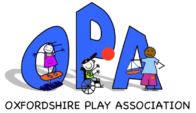What is Playwork?
Playworkers work with children and young people aged approximately 4-14 to provide them with rich play environments in which they can have free choice and control over their play, use their imaginations and develop their skills and knowledge at their own individual pace. They understand that children should not be in a cage – that they need space to be free range, make choices and explore the world. Playworkers aim to create a rich play environment that stimulates children’s natural drive to play.
Playworkers understand that play is a right for all children and young people, as declared by Article 31 of the United Nations Convention on the Rights of the Child. They know that children and young people have a natural drive to play, and that this play instinct has helped the human race (and many other animals) to survive and evolve, and to develop skills that are useful, and often essential, for life. Play helps to develop many skills including:
- physical skills (e.g. climbing, jumping, balancing, fighting, strength, coordination, reactions, risk awareness)
- social skills (e.g. negotiating, sharing, debating, arguing, communication, listening, standing up for yourself)
- intellectual skills (e.g. problem-solving, reading, vocabulary, reasoning, time, general knowledge)
- creative skills (e.g. artistic skills (painting, mosaic, woodwork, drawing, etc), fine motor skills, imagination)
- emotional skills (e.g. regulation of emotions, resilience, empathy, understanding how feelings affect actions)
Playworkers understand that free play enables children and young people to ‘play out’ any difficult or confusing issues that affect their lives, and can have a therapeutic affect. ‘Free’ play is when children are able to direct and command their own play, with no adult interference, no adult rules (such as with board games) and no adult incentive (such as prizes).
Playworkers adhere to a guiding framework for their work called the ‘Playwork Principles’. More information about these can be found on the Playwork Principles page.
Playwork Settings
Playworkers work with age 4-14 (approximately) in a variety of environments, often in out-of-school settings such as after school clubs, breakfast clubs, holiday playschemes, playbuses, adventure playgrounds and as play rangers. They understand that children are exposed to a lot of education in their lives (through school, homework and classes) and although education is important, play is equally important as it increases health, happiness and wellbeing. The playworker’s job is to facilitate high quality play opportunities for children and young people, and they do this by preparing an exciting, stimulating and enticing play space, by only getting involved in play if asked to by a child/children and by valuing the playing child above all else.
The Play Cycle
Playworkers are able to observe a number of stages in a child’s play, and use the following terms to describe what is happening in play.
Play Drive: The idea to play starts inside the child’s mind, and they might then do an action or send out a signal (a Play Cue) to start the play.
Play Cue: a signal sent out by the child (to another child, children, adult, animal or even an inanimate object) inviting the other to join in with the play. For example, a child might throw another child a ball to catch, or they may say, “Shall we play?”
Play Return: this is a signal returned in response to a Play Cue showing that they would like to join in the play. For example, a child might catch a ball thrown to them, and throw it back.
Play Flow: When a child is absorbed in their play, they are in the Play Flow, which can last for minutes, hours or sometimes days at a time.
The Play Frame: The imaginary or real boundary around the child’s/children’s play, which can be altered by changing the space, people, things, etc in it to maintain and extend the Play Flow.
Annihilation: When a child/children decide to end the play (or when they are forced to end their play, or their play is interrupted by an adult) the Play Frame ‘pops’ and is extinguished, and the cycle of play ends.
The Play Cycle: All the above elements together constitute the Play Cycle, starting with the Play Drive and ending with annihilation of the play.
This comes from the ground-breaking Colorado Paper by Perry Else and Gordon Sturrock. You can read it here.
